Planet Jupiter, Observed By The Juno Probe On September 1, 2017.

Planet Jupiter, observed by the Juno probe on September 1, 2017.
More Posts from Xyhor-astronomy and Others
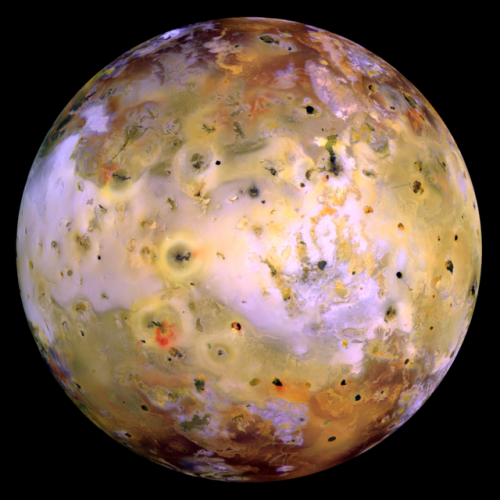
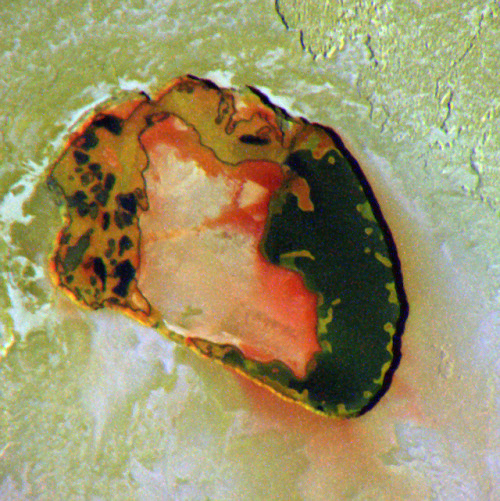
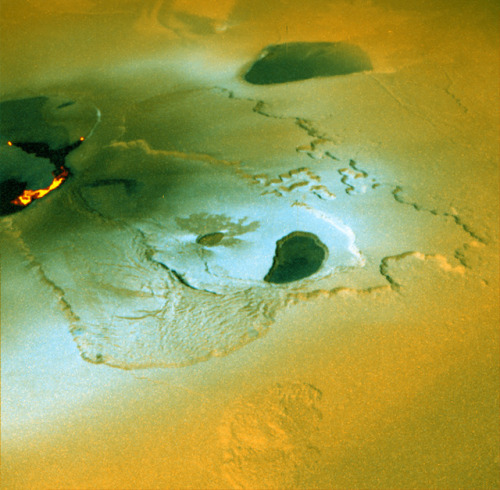
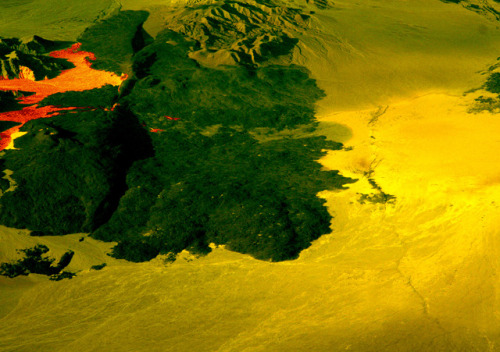
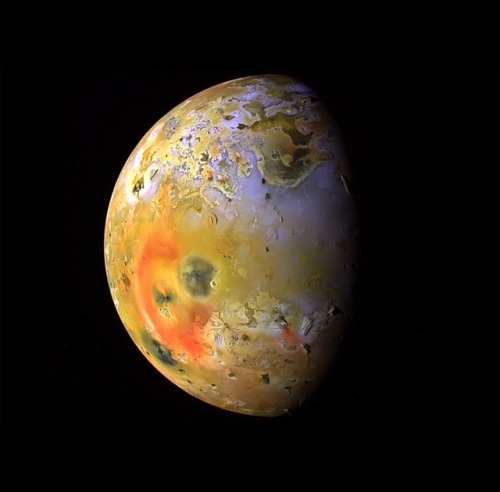
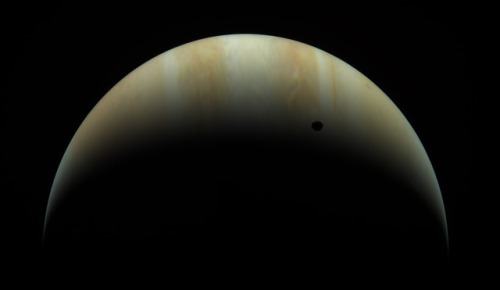
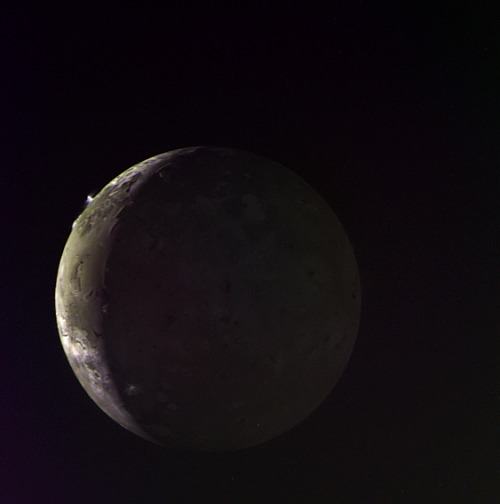
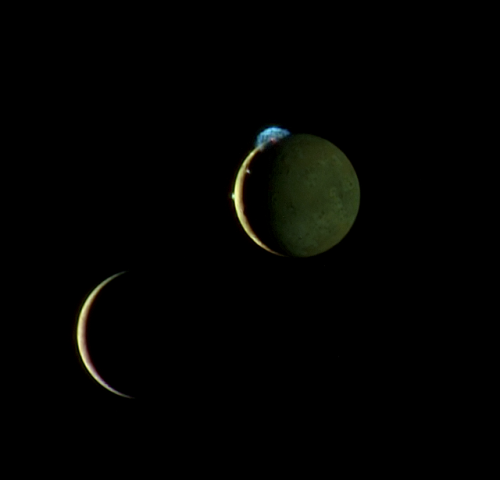
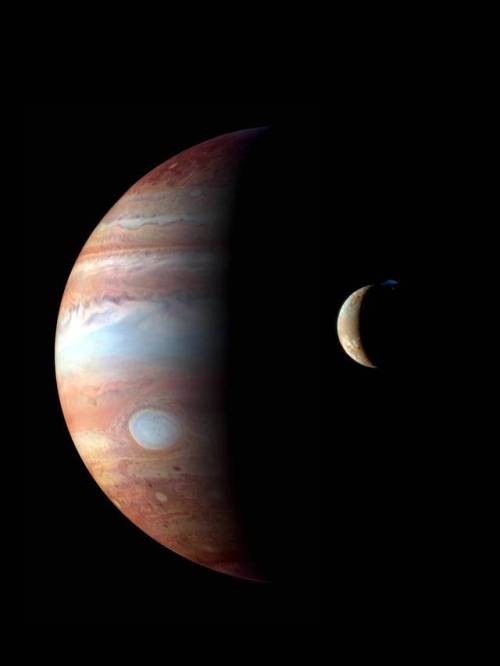
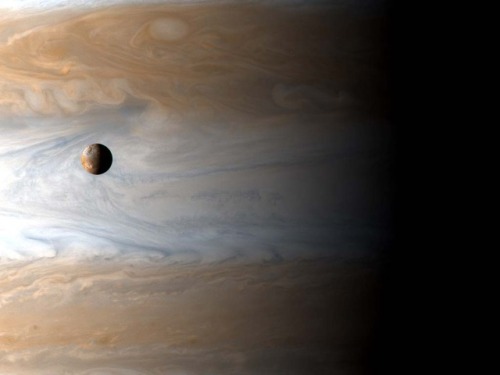
Io - The Volcanic Moon
Looking like a giant pizza covered with melted cheese and splotches of tomato and ripe olives, Io is the most volcanically active body in the solar system. Volcanic plumes rise 300 km (190 miles) above the surface, with material spewing out at nearly half the required escape velocity.
A bit larger than Earth’s Moon, Io is the third largest of Jupiter’s moons, and the fifth one in distance from the planet.
Although Io always points the same side toward Jupiter in its orbit around the giant planet, the large moons Europa and Ganymede perturb Io’s orbit into an irregularly elliptical one. Thus, in its widely varying distances from Jupiter, Io is subjected to tremendous tidal forces. These forces cause Io’s surface to bulge up and down (or in and out) by as much as 100 m (330 feet)! Compare these tides on Io’s solid surface to the tides on Earth’s oceans. On Earth, in the place where tides are highest, the difference between low and high tides is only 18 m (60 feet), and this is for water, not solid ground!
This tidal pumping generates a tremendous amount of heat within Io, keeping much of its subsurface crust in liquid form seeking any available escape route to the surface to relieve the pressure. Thus, the surface of Io is constantly renewing itself, filling in any impact craters with molten lava lakes and spreading smooth new floodplains of liquid rock. The composition of this material is not yet entirely clear, but theories suggest that it is largely molten sulfur and its compounds (which would account for the varigated coloring) or silicate rock (which would better account for the apparent temperatures, which may be too hot to be sulfur). Sulfur dioxide is the primary constituent of a thin atmosphere on Io. It has no water to speak of, unlike the other, colder Galilean moons. Data from the Galileo spacecraft indicates that an iron core may form Io’s center, thus giving Io its own magnetic field.
Io was discovered on 8 January 1610 by Galileo Galilei. The discovery, along with three other Jovian moons, was the first time a moon was discovered orbiting a planet other than Earth.

Eruption of the Tvashtar volcano on Jupiter’s moon Io, photographed by New Horizons.
Image credit: NASA/JPL/Galileo/New Horizons ( Stuart Rankin | Kevin Gill)
Source: NASA
The NASA Village
Today in the NASA Village… Making More with Less

Stacey Boland works at NASA’s Jet Propulsion Laboratory (JPL) on missions that use remote sensing instruments for Earth observation. From space, we can learn so much about our changing environment here on Earth.
Maximizing science research requires finding creative and cost effective ways to do it! Her team developed the ISS-RapidScat instrument using left over equipment NASA had in storage from a program launched in the 1990’s. ISS-RapidScat is an external payload mounted to the outside of the Columbus module, part of the International Space Station. ISS-RapidScat measures ocean wind speed and direction to help track tropical cyclones and hurricanes. Stacey’s team was able to get a functioning piece of hardware for about a tenth the cost of a traditional “small” Earth science mission.
Stacey said, “It wasn’t easy, but it was worth it! Working in the space program doesn’t require perfection - but it does require passion and hard work! We work as a team here at NASA and everyone’s role is important. We rely on each other to do our best, regardless of what part of the mission is “ours.” All the parts need to work together for it to be a success and that takes teamwork and good communication!”
Stacey’s story represents how being creative in the NASA Village can really make a difference!

Where did Stacey get her hunger for space? “When I was growing up, my dad and I would learn about each shuttle mission and then watch launches on TV together. It was fun learning about science and exploration together. Now, as a parent, I’m continuing on that tradition with my son”
“I was able to watch the SpaceX-4 launch in person with my mom, dad, husband, and son”, Stacy said. “It was absolutely incredible to share that experience with them. My son still talks about it and has been practicing drawing rockets ever since. He often asks when we can go back to Florida to see another one!”
Experiencing a rocket launch in person is amazing. Feeling the sound waves from the engines push against your body is quite a rush. And when it is hardware you helped create, on its way into space, it makes that experience even more special.
Next time on the NASA Village… A visit to the NASA Village inspires a lifelong career.
Do you want more stories? Find our NASA Villagers here!
A Hitchhiker’s Ride to Space
This month, we are set to launch the latest weather satellite from the National Oceanic and Atmospheric Administration (NOAA). The Joint Polar Satellite System-1, or JPSS-1, satellite will provide essential data for timely and accurate weather forecasts and for tracking environmental events such as forest fires and droughts.

Image Credit: Ball Aerospace
JPSS-1 is the primary satellite launching, but four tiny satellites will also be hitchhiking a ride into Earth orbit. These shoebox-sized satellites (part of our CubeSat Launch Initiative) were developed in partnership with university students and used for education, research and development. Here are 4 reasons why MiRaTA, one of the hitchhikers, is particularly interesting…

Miniaturized Weather Satellite Technology
The Microwave Radiometer Technology Acceleration (MiRaTA) CubeSat is set to orbit the Earth to prove that a small satellite can advance the technology necessary to reduce the cost and size of future weather satellites. At less than 10 pounds, these nanosatellites are faster and more cost-effective to build and launch since they have been constructed by Principal Investigator Kerri Cahoy’s students at MIT Lincoln Laboratory (with lots of help). There’s even a chance it could be put into operation with forecasters.

The Antenna? It’s a Measuring Tape
That long skinny piece coming out of the bottom right side under MiRaTA’s solar panel? That’s a measuring tape. It’s doubling as a communications antenna. MiRaTA will measure temperature, water vapor and cloud ice in Earth’s atmosphere. These measurements are used to track major storms, including hurricanes, as well as everyday weather. If this test flight is successful, the new, smaller technology will likely be incorporated into future weather satellites – part of our national infrastructure.

Tiny Package Packing a Punch MiRaTA will also test a new technique using radio signals received from GPS satellites in a higher orbit. They will be used to measure the temperature of the same volume of atmosphere that the radiometer is viewing. The GPS satellite measurement can then be used for calibrating the radiometer. “In physics class, you learn that a pencil submerged in water looks like it’s broken in half because light bends differently in the water than in the air,” Principal Investigator Kerri Cahoy said. “Radio waves are like light in that they refract when they go through changing densities of air, and we can use the magnitude of the refraction to calculate the temperature of the surrounding atmosphere with near-perfect accuracy and use this to calibrate a radiometer.”

What’s Next?
In the best-case scenario, three weeks after launch MiRaTA will be fully operational, and within three months the team will have obtained enough data to study if this technology concept is working. The big goal for the mission—declaring the technology demonstration a success—would be confirmed a bit farther down the road, at least half a year away, following the data analysis. If MiRaTA’s technology validation is successful, Cahoy said she envisions an eventual constellation of these CubeSats orbiting the entire Earth, taking snapshots of the atmosphere and weather every 15 minutes—frequent enough to track storms, from blizzards to hurricanes, in real time.
Learn more about MiRaTA
Watch the launch!

The mission is scheduled to launch this month (no sooner than Nov. 14), with JPSS-1 atop a United Launch Alliance (ULA) Delta II rocket lifting off from Space Launch Complex 2 at Vandenberg Air Force Base in California. You’ll be able to watch on NASA TV or at nasa.gov/live.

Watch the launch live HERE on Nov. 14, liftoff is scheduled for Tuesday, 4:47 a.m.!
Make sure to follow us on Tumblr for your regular dose of space: http://nasa.tumblr.com.
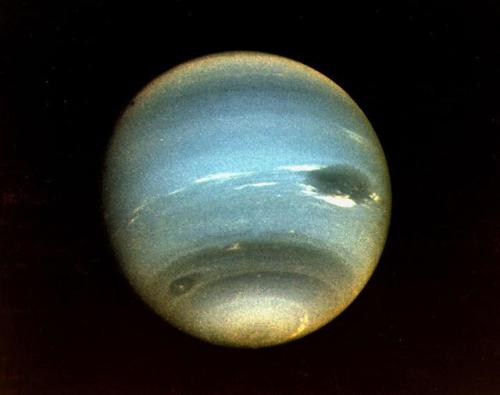
Image of the planet Neptune seen by the space probe Voyager 2
Image credit: NASA/JPL

Hubble peeks inside a stellar cloud
These bright stars shining through what looks like a haze in the night sky are part of a young stellar grouping in one of the largest known star formation regions of the Large Magellanic Cloud (LMC), a dwarf satellite galaxy of the Milky Way. The image was captured by the NASA/ESA Hubble Space Telescope’s Wide Field Planetary Camera 2.
The stellar grouping is known to stargazers as NGC 2040 or LH 88. It is essentially a very loose star cluster whose stars have a common origin and are drifting together through space. There are three different types of stellar associations defined by their stellar properties. NGC 2040 is an OB association, a grouping that usually contains 10–100 stars of type O and B — these are high-mass stars that have short but brilliant lives. It is thought that most of the stars in the Milky Way were born in OB associations.
There are several such groupings of stars in the LMC, including one previously featured as a Hubble Picture of the Week. Just like the others, LH 88 consists of several high-mass young stars in a large nebula of partially ionised hydrogen gas, and lies in what is known to be a supergiant shell of gas called LMC 4.
Over a period of several million years, thousands of stars may form in these supergiant shells, which are the largest interstellar structures in galaxies. The shells themselves are believed to have been created by strong stellar winds and clustered supernova explosions of massive stars that blow away surrounding dust and gas, and in turn trigger further episodes of star formation.
The LMC is the third closest galaxy to our Milky Way. It is located some 160 000 light-years away, and is about 100 times smaller than our own.
This image, which shows ultraviolet, visible and infrared light, covers a field of view of approximately 1.8 by 1.8 arcminutes.
A version of this image was entered into the Hubble’s Hidden Treasures Image Processing Competition by contestant Eedresha Sturdivant. Hidden Treasures is an initiative to invite astronomy enthusiasts to search the Hubble archive for stunning images that have never been seen by the general public.
These bright stars shining through what looks like a haze in the night sky are part of a young stellar grouping in one of the largest known star formation regions of the Large Magellanic Cloud (LMC), a dwarf satellite galaxy of the Milky Way. The image was captured by the NASA/ESA Hubble Space Telescope’s Wide Field Planetary Camera 2.
The stellar grouping is known to stargazers as NGC 2040 or LH 88. It is essentially a very loose star cluster whose stars have a common origin and are drifting together through space. There are three different types of stellar associations defined by their stellar properties. NGC 2040 is an OB association, a grouping that usually contains 10–100 stars of type O and B — these are high-mass stars that have short but brilliant lives. It is thought that most of the stars in the Milky Way were born in OB associations.
There are several such groupings of stars in the LMC, including one previously featured as a Hubble Picture of the Week. Just like the others, LH 88 consists of several high-mass young stars in a large nebula of partially ionised hydrogen gas, and lies in what is known to be a supergiant shell of gas called LMC 4.
Over a period of several million years, thousands of stars may form in these supergiant shells, which are the largest interstellar structures in galaxies. The shells themselves are believed to have been created by strong stellar winds and clustered supernova explosions of massive stars that blow away surrounding dust and gas, and in turn trigger further episodes of star formation.
The LMC is the third closest galaxy to our Milky Way. It is located some 160 000 light-years away, and is about 100 times smaller than our own.
This image, which shows ultraviolet, visible and infrared light, covers a field of view of approximately 1.8 by 1.8 arcminutes.
A version of this image was entered into the Hubble’s Hidden Treasures Image Processing Competition by contestant Eedresha Sturdivant. Hidden Treasures is an initiative to invite astronomy enthusiasts to search the Hubble archive for stunning images that have never been seen by the general public.
ESA/Hubble, NASA and D. A Gouliermis. Acknowledgement: Flickr user Eedresha Sturdivant
https://www.spacetelescope.org/images/potw










The Largest Black Hole Merger Of All-Time Is Coming, And Soon
“Over in Andromeda, the nearest large galaxy to the Milky Way, a number of unusual systems have been found. One of them, J0045+41, was originally thought to be two stars orbiting one another with a period of just 80 days. When additional observations were taken in the X-ray, they revealed a surprise: J0045+41 weren’t stars at all.”
When you look at any narrow region of the sky, you don’t simply see what’s in front of you. Rather, you see everything along your line-of-sight, as far as your observing power can take you. In the case of the Panchromatic Hubble Andromeda Treasury, where hundreds of millions of stars were captured in impressive fashion, background objects thousands of times as distant can also be seen. One of them, J0045+41, was originally thought to be a binary star system that was quite tight: with just an 80 day orbital period. Follow-up observations in the X-ray, however, revealed that it wasn’t a binary star system after all, but an ultra-distant supermassive black hole pair, destined to merge in as little as 350 years. If we build the right observatory in space, we’ll be able to observe the entire inspiral-and-merger process for as long as we like!
Come get the full story, and some incredible pictures and visuals, on today’s Mostly Mute Monday!

Composed of gas and dust, the pictured pillar resides in a tempestuous stellar nursery called the Carina Nebula, located 7500 light-years away in the southern constellation of Carina.
Credit: NASA, ESA and the Hubble SM4 ERO Team

The Heart Nebula or IC 1805, lies some 7500 light years away from Earth and is located in the Perseus Arm of the Galaxy in the constellation Cassiopeia. This is an emission nebula showing glowing ionized hydrogen gas and darker dust lanes.
Image Credit: Simon Addis

Should there be a holiday called Astronomy Day?
Where lights are to be turned off for the entire night so everyone could see the stars?
Chasing the Shadow of Neptune’s Moon Triton
Our Flying Observatory

Our flying observatory, called SOFIA, carries a 100-inch telescope inside a Boeing 747SP aircraft. Scientists onboard study the life cycle of stars, planets (including the atmosphere of Mars and Jupiter), nearby planetary systems, galaxies, black holes and complex molecules in space.
AND in just a few days SOFIA is going on a special flight to chase the shadow of Neptune’s moon Triton as it crosses Earth’s surface!
In case you’re wondering, SOFIA stands for: Stratospheric Observatory for Infrared Astronomy.
Triton

Triton is 1,680 miles (2,700 km) across, making it the largest of the 13 moons orbiting Neptune. Unlike most large moons in our solar system, Triton orbits in the opposite direction of Neptune, called a retrograde orbit. This backward orbit leads scientists to believe that Triton formed in an area past Neptune, called the Kuiper Belt, and was pulled into its orbit around Neptune by gravity.
The Voyager 2 spacecraft flew past Neptune and Triton in 1989 and found that Triton’s atmosphere is made up of mostly nitrogen…but it has not been studied in nearly 16 years!
Occultations are Eclipse-Like Events

An occultation occurs when an object, like a planet or a moon, passes in front of a star and completely blocks the light from that star. As the object blocks the star’s light, it casts a faint shadow on Earth’s surface.
But unlike an eclipse, these shadows are not usually visible to the naked eye because the star and object are much smaller and not nearly as bright as our sun. Telescopes with special instruments can actually see these shadows and study the star’s light as it passes near and around the object – if they can be in the right place on Earth to catch the shadow.
Chasing Shadows

Scientists have been making advanced observations of Triton and a background star. They’ve calculated exactly where Triton’s faint shadow will fall on Earth! Our SOFIA team has designed a flight path that will put SOFIA (the telescope and aircraft) exactly in the center of the shadow at the precise moment that Triton and the star will align.
This is no easy feat because the shadow is moving at more than 53,000 mph while SOFIA flies at Mach 0.85 (652 mph), so we only have about two minutes to catch the shadow!! But our SOFIA team has previously harnessed the aircraft’s mobility to study Pluto from inside the center of its occultation shadow, and is ready to do it again to study Triton!
What We Learn From Inside the Shadow

From inside the shadow, our team on SOFIA will study the star’s light as it passes around and through Triton’s atmosphere. This allows us to learn more about Triton’s atmosphere, including its temperature, pressure, density and composition!
Our team will use this information to examine if Triton’s atmosphere has changed since our Voyager 2 spacecraft flew past it in 1989. That’s a lot of information from a bit of light inside a shadow! Similar observations of Uranus in 1977, from our previous flying observatory, led to the discovery of rings around that planet!
International Ground-Based Support

Ground-based telescopes across the United States and Europe – from Scotland to the Canary Islands – will also be studying Triton’s occultation. Even though most of these telescopes will not be in the center of the shadow, the simultaneous observations, from different locations on Earth, will give us information about how Triton’s atmosphere varies across its latitudes.
This data from across the Earth and from onboard SOFIA will help researchers understand how Triton’s atmosphere is distorted at different locations by its high winds and its strong tides!
Make sure to follow us on Tumblr for your regular dose of space: http://nasa.tumblr.com.
-
 89rooms liked this · 1 year ago
89rooms liked this · 1 year ago -
 danrush777 liked this · 3 years ago
danrush777 liked this · 3 years ago -
 earthmoonlotus reblogged this · 3 years ago
earthmoonlotus reblogged this · 3 years ago -
 earthmoonlotus liked this · 3 years ago
earthmoonlotus liked this · 3 years ago -
 naturesbeauty420 reblogged this · 4 years ago
naturesbeauty420 reblogged this · 4 years ago -
 ii-shadows reblogged this · 4 years ago
ii-shadows reblogged this · 4 years ago -
 frederickwilliams liked this · 4 years ago
frederickwilliams liked this · 4 years ago -
 paddy0 liked this · 4 years ago
paddy0 liked this · 4 years ago -
 perpetuo-errans reblogged this · 6 years ago
perpetuo-errans reblogged this · 6 years ago -
 dearkurisu liked this · 6 years ago
dearkurisu liked this · 6 years ago -
 purebloodslytherin182 liked this · 6 years ago
purebloodslytherin182 liked this · 6 years ago -
 kidd-withno-ambitions reblogged this · 6 years ago
kidd-withno-ambitions reblogged this · 6 years ago -
 gren-o-uille reblogged this · 6 years ago
gren-o-uille reblogged this · 6 years ago -
 gren-o-uille liked this · 6 years ago
gren-o-uille liked this · 6 years ago -
 haldisu reblogged this · 6 years ago
haldisu reblogged this · 6 years ago -
 design12-beauty reblogged this · 6 years ago
design12-beauty reblogged this · 6 years ago -
 lovelywomenandsissies liked this · 6 years ago
lovelywomenandsissies liked this · 6 years ago -
 anima-di-sole reblogged this · 6 years ago
anima-di-sole reblogged this · 6 years ago -
 pnwbreeze-blog reblogged this · 6 years ago
pnwbreeze-blog reblogged this · 6 years ago -
 pnwbreeze-blog liked this · 6 years ago
pnwbreeze-blog liked this · 6 years ago -
 blissfullybe reblogged this · 6 years ago
blissfullybe reblogged this · 6 years ago -
 caelandterra reblogged this · 6 years ago
caelandterra reblogged this · 6 years ago -
 barbswired reblogged this · 7 years ago
barbswired reblogged this · 7 years ago -
 pasteleriasilvestre reblogged this · 7 years ago
pasteleriasilvestre reblogged this · 7 years ago -
 pasteleriasilvestre liked this · 7 years ago
pasteleriasilvestre liked this · 7 years ago -
 olhosumidos reblogged this · 7 years ago
olhosumidos reblogged this · 7 years ago -
 mypresidentialview reblogged this · 7 years ago
mypresidentialview reblogged this · 7 years ago -
 gooper70 liked this · 7 years ago
gooper70 liked this · 7 years ago -
 toufle reblogged this · 7 years ago
toufle reblogged this · 7 years ago -
 toufle liked this · 7 years ago
toufle liked this · 7 years ago -
 papisboyy reblogged this · 7 years ago
papisboyy reblogged this · 7 years ago -
 innerdonutcollectr reblogged this · 7 years ago
innerdonutcollectr reblogged this · 7 years ago -
 innerdonutcollectr liked this · 7 years ago
innerdonutcollectr liked this · 7 years ago -
 ghosts-of-imperial-russia liked this · 7 years ago
ghosts-of-imperial-russia liked this · 7 years ago -
 marilena56 reblogged this · 7 years ago
marilena56 reblogged this · 7 years ago -
 consolareis liked this · 7 years ago
consolareis liked this · 7 years ago
For more content, Click Here and experience this XYHor in its entirety!Space...the Final Frontier. Let's boldly go where few have gone before with XYHor: Space: Astronomy & Spacefaring: the collection of the latest finds and science behind exploring our solar system, how we'll get there and what we need to be prepared for!
128 posts